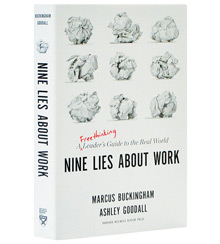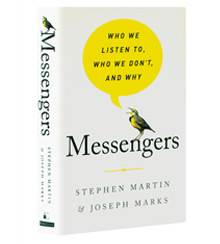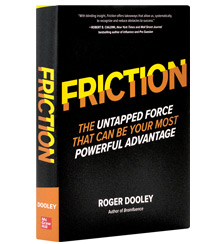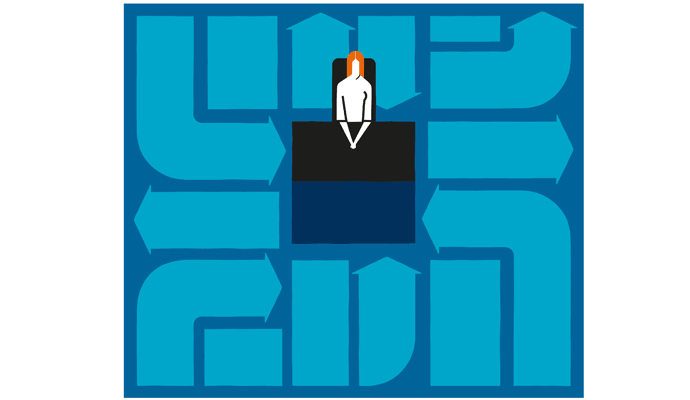Best Business Books 2019: Management
Get real, be heard, grease the skids.
Marcus Buckingham and Ashley Goodall
Nine Lies About Work: A Freethinking Leader’s Guide to the Real World (Harvard Business Review Press, 2019)
*A TOP SHELF PICK
Stephen Martin and Joseph Marks
Messengers: Who We Listen To, Who We Don’t, and Why (PublicAffairs, 2019)
Roger Dooley
Friction: The Untapped Force That Can Be Your Most Powerful Advantage (McGraw-Hill, 2019)
In 1954, the discipline of management was neatly encapsulated by Peter Drucker in the pages of a single book, The Practice of Management. This year’s best business books on management reflect how much the discipline has changed in the past 65 years, and how fuzzy the boundaries separating fields have become.
Nine Lies About Work, by Marcus Buckingham and Ashley Goodall, the year’s best management book, challenges the assumptions that underlie contemporary managerial practices, many of which date back to Drucker’s day. In doing so, the book offers a glimpse of a new management paradigm that may prove to be better suited to the times. Messengers, by Stephen Martin and Joseph Marks, prompts us to see managers as a living, breathing communication medium — and it describes the traits that can ensure the messages they deliver will be heard. And Friction, by Roger Dooley, suggests that if managers turn their attention to simplifying anything customers and employees need to do, they’ll happily do more of it.
Control is the root of all evil
Nine Lies About Work is a deceptive book. At first, it seems like a contrarian take on a few managerial truisms, such as “the best plan wins” and “people need feedback.” But it adds up to something much more subversive — a stealth attack on the whole discipline of management. “As you read, you’ll realize that these Nine Lies have taken hold because each satisfies the organization’s need for control,” write authors Marcus Buckingham, whose previous books were instrumental in extending strengths-based practice to business, and Ashley Goodall, senior vice president of leadership and team intelligence at Cisco. “This is why you are told that your organization’s culture is monolithic, that the plan must be adhered to, that work must be aligned through cascaded goals, that humans must be molded into well-roundedness and given constant feedback until they become so, and that each one of us must rate the others so as to conform most closely to the prescribed models of leadership, performance, and potential.”
What’s the problem with control? Nothing, in small doses. But taken to extremes, control quashes individuality, and all the energy and creativity that accompanies it. Excessive control turns people into automatons — which brings to mind a connection to the ongoing debate involving technologies such as artificial intelligence and machine learning: With machines becoming capable of imitating humans, why would any company need or want humans to imitate machines?
Managers won’t be surprised by some of the nine lies that Buckingham and Goodall seek to expose. Consider Lie #6: “People can reliably rate other people.” After several pages describing the ubiquitous, increasingly complex systems designed to rank employee performance and potential, they drop the bomb: “It is going to bother you to learn, then, that in the real world none of this works. None of the mechanisms and meetings — not the models, not the consensus sessions, not the exhaustive competencies, not the carefully calibrated rating scales.…”
After several pages describing the ubiquitous, increasingly complex systems designed to rank employee performance and potential, they drop the bomb: “In the real world none of this works.”
Worse, they prove it, citing the idiosyncratic rater effect (in effect, ratings reveal more about the rater than the rated), data insufficiency, and the not-so-wise crowd — all of which will confirm the suspicions of the many managers who despise talent reviews.
Some of the other lies are more surprising. Take Lie #1: “People care which company they work for.” Here Buckingham and Goodall undercut the legendary power of culture. They say that when companies measure the experience of employees at work, it always varies widely among individuals. Moreover, the experience scores of employees within companies always vary more than the experience scores of employees between companies.
This is the opposite of what you would expect, if the experience of working in a particular company held sway. “Any ideas — like the idea of culture — that rest on the assumption that our experience of a company is uniform, no matter where we sit, don’t hold up,” conclude the authors. “While people might care which company they join, they don’t care which company they work for.”
Nine Lies About Work goes on like this for nine chapters. For each lie there is a truth: The team an employee works for matters more than the company; what wins is the best intelligence, not the best plan; the best companies cascade meaning, not goals; the best people are spikey (great at something), not well-rounded; and so forth.
In the end, these truths point to a new vision of management that is very different from the form practiced at most large organizations. The “freethinking” manager is one, write the authors in a passage worth quoting at length, “who embraces a world in which the weird uniqueness of each individual is seen not as a flaw to be ground down but as a mess worth engaging with, the raw material for all healthy ethical, thriving organizations; a leader who rejects dogma and instead seeks out evidence; who values emergent patterns above received wisdom; who thrills to the power of teams; who puts faith in findings, not philosophy; and above all, a leader who knows that the only way to make the world better tomorrow is to have the courage and the wit to face up to how it really is today.”
Most of all, argue the authors, your effectiveness as a manager is linked to “how seriously and intelligently you cultivate your own idiosyncrasy, and to what end. The deeper and more extreme your idiosyncrasy becomes, the more passionately your followers follow — and while this is frustrating to us when we happen to disagree with the ends of a particular leader, it is so nonetheless.” That vision makes Nine Lies About Work the year’s best business book on management.
The manager is the message
The pioneering Canadian communications theorist Marshall McLuhan doesn’t get so much as a cameo in Messengers. But his ghost hovers throughout the pages. McLuhan explored the effect of media on how we receive and perceive messages; the authors, Stephen Martin and Joseph Marks (the CEO of Influence at Work UK and a researcher at University College London, respectively), explore the effect of the messenger on the message.
“We tend to judge an idea not on its merits, but according to how we judge the person putting it forward,” write Martin and Marks. “We fail to separate the idea being communicated in a message from the person or entity conveying it. This commonly overlooked insight…illuminates a fundamental feature of the effective messenger. They become the message.”
The McLuhan-esque idea that the messenger is the message should pique the interest of managers at all levels. They are, after all, one of the principal mediums through which organizational messages, whether strategy or cultural norms, are delivered. Moreover, managers’ ability to effectively deliver messages can determine the success of their organization and the trajectory of their careers.
The core content of Messengers is eight traits, drawn from a wide range of research conducted over the past 60 years, which determine whether or not a messenger will be heeded. Martin and Marks organize the traits into two categories: hard and soft. “Hard messengers are more likely to have their messages accepted because audiences perceive them to possess superior status,” they explain. “Soft messengers, in contrast, win acceptance of their messages because they are perceived to possess a connectedness with an audience.”
The four hard traits are socioeconomic position, competence, dominance, and attractiveness. It’s hard not to be embarrassed as the authors relate the litany of research results that reveal how we humans are swayed by an expensive outfit or a pretty face. Apparently you can dress for success, at least in terms of delivering messages.
“High-status individuals are more likely to have their opinions heard and valued. They are also more likely to be awarded more respect, recognition, and importance than those lower down the chain,” report the authors. “In short, as messengers they command greater attention and are listened to more often.”
Managers are endowed with some measure of the hard trait of dominance by dint of their positional authority. When University of Utah business ethics professor Arthur Brief asked MBA students if they would vote to recall a drug with significant risks of adverse effects in a board meeting where the chair was not in favor of the recall, 33 percent said that they would vote to recall it. When MBA students were given the same scenario, but told the chair supported the recall, 76 percent said they would vote for it.
The four soft traits are warmth, vulnerability, trustworthiness, and charisma. Trustworthiness is the most powerful of all the traits, say the authors. The simplest way to build trust is to smile. “According to psychologists who developed computational models of faces based on how trustworthy people rate them to be, it would seem that while the untrustworthy face bears an expression remarkably similar to anger, the trustworthy face looks happy,” they write.
Messengers isn’t a how-to book. But the final chapter contains some interesting guidance for combining and applying the soft and hard traits. Martin and Marks find, for example, that different cultures respond to different traits. In an interdependent culture, which emphasizes cohesion and collective action, such as a manufacturing plant, soft traits are likely to be more effective than hard traits. The opposite holds for independent cultures that emphasize individual performance, such as a commission-only sales organization.
Messengers is not written for managers per se, but they will find it is well worth sussing out the book’s insights. If nothing else, it can help leaders avoid the curse of Cassandra. In Greek mythology, the god Apollo tried to seduce Cassandra by granting her the gift of prophesy. But she spurned him anyway, and Apollo added a cruel twist — he ensured that no one would listen to or act upon her always-correct forecasts.
Put on your friction goggles
Roger Dooley sees friction everywhere, and in his book Friction, he urges every manager to be on the lookout for it, too. “My intention for this book is to give you and every other reader your very own pair of friction goggles,” the author, speaker, and entrepreneur writes. “These goggles will help you discover friction, which I define as ‘the unnecessary expenditure of time, effort, or money in performing a task,’ in all kinds of places.”
Friction — or more accurately, the lack of it — is the secret to Amazon’s success, according to Dooley. “While many companies focus on motivating their customers to take desired actions with ads, bribes, and other nudges,” he explains, “Amazon is uniquely focused on making things easier to do. This focus on reducing friction is a key reason for Amazon’s emergence as the world’s biggest, fastest-growing retailer. It’s also driving high growth in many other parts of their business.”
Consider Amazon’s 1-Click buying process, Prime offering with no-cost shipping and streaming services, Go stores sans checkout, and Alexa-enabled voice computing. All of these are aimed at greasing the skids for consumers. And Amazon’s success offers dramatic proof of Dooley’s law of friction: “Decreasing friction increases action.”
Dooley attributes lots of successful disruptions — the Roman roads that sped the movement of information, goods, and Julius Caesar’s legionnaires across Europe; Montgomery Ward’s mail order catalog; Uber’s digitized cab hailing — to their ability to reduce friction. “Everyday experiences we take for granted may contain plenty of friction,” he writes. “Could smartphones or some other transformative technology provide ways to reduce customer effort in your business?”
The customer experience isn’t the only target for managers who want to attack friction. Red tape, organizational complexity, unnecessary meetings, the flood of emails — all these things and more create friction in the operations of a company and slow employees down.
This isn’t news, exactly. Henry Ford reduced manufacturing friction with the assembly line and Toyota attacked it with just-in-time and kanban. Dooley also points to Jack Welch’s de-layering and bureaucracy busting at General Electric as an exemplar of internal friction reduction. But as the author rightly notes, “everybody may know about friction, but in many cases they aren’t doing anything about it.”
Friction reads a lot like a keynote speech — fast and personable with many intriguing stories, and without a whole lot of prescriptive depth. What earns this title a slot among the year’s best business books about management is its power to raise the friction consciousness of managers. If Dooley gets you doing something about friction, he will have delivered a full measure of value.
Author profile:
- Theodore Kinni is a contributing editor of strategy+business. He blogs at Reading, Writing re: Management and is @TedKinni on Twitter.








